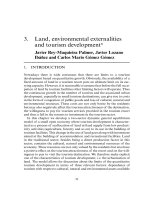THE ECONOMICS OF MONEY,BANKING, AND FINANCIAL MARKETS 452
Bạn đang xem bản rút gọn của tài liệu. Xem và tải ngay bản đầy đủ của tài liệu tại đây (43.63 KB, 1 trang )
420
PA R T V
Central Banking and the Conduct of Monetary Policy
for a total of only $190 considerably less than the $1000 we calculated with the
simple model above. Another way of saying this is that currency has no multiple
deposit expansion, while deposits do. Thus, if some proceeds from loans are used
to raise the holdings of currency, there is less multiple expansion overall, and the
money supply will not increase by as much as our simple model of multiple
deposit creation tells us.
Another situation ignored in our model is one in which banks do not make
loans or buy securities in the full amount of their excess reserves. If Bank A
decides to hold on to all $90 of its excess reserves, no deposits would be made in
Bank B, and this would also stop the deposit creation process. The total increase
in deposits would again be only $100 and not the $1000 increase in our example.
Hence, if banks choose to hold all or some of their excess reserves, the full expansion of deposits predicted by the simple model of multiple deposit creation again
does not occur.
Our examples indicate that the Bank of Canada is not the only player whose
behaviour influences the level of deposits and therefore the money supply.
Depositors decisions regarding how much currency to hold and banks decisions
regarding the amount of reserves to hold can cause the money supply to change.
FACTO RS T HAT D ET ERM I NE T HE MO NE Y SUP P LY
Our critique of the simple model shows how we can expand on it to discuss all
the factors that affect the money supply. Let s look at changes in each factor in
turn, holding all other factors constant.
Changes in
the Nonborrowed
Monetary
Base, MBn
As shown earlier in the chapter, the Bank of Canada s open market purchases
increase the nonborrowed monetary base, and its open market sales decrease it.
Holding all other variables constant, an increase in MBn arising from an open market purchase increases the amount of the monetary base and reserves, so that multiple deposit creation occurs and the money supply increases. Similarly, an open
market sale that decreases MBn shrinks the amount of the monetary base and
reserves, thereby causing a multiple contraction of deposits and the money supply decreases. We have the following result: The money supply is positively
related to the nonborrowed monetary base, MBn.
Changes in
Borrowed
Reserves (BR)
from the Bank
of Canada
An increase in advances from the Bank of Canada provides additional borrowed
reserves, and thereby increases the amount of the monetary base and reserves, so
that multiple deposit creation occurs and the money supply increases. If banks
reduce the level of their loans from the Bank of Canada, all other variables held
constant, the monetary base and amount of reserves fall, and the money supply
would decrease. The result is this: The money supply is positively related to
the level of borrowed reserves, BR, from the Bank of Canada.
Changes in
the Desired
Reserve
Ratio, r
If the desired reserve ratio on chequable deposits increases while all other variables, such as the monetary base, stay the same, we have seen that there is less
multiple deposit expansion, and hence the money supply falls. If, on the other
hand, the desired reserve ratio falls, multiple deposit expansion would be higher
and the money supply would rise. We now have the following result: The money
supply is negatively related to the desired reserve ratio, r.









